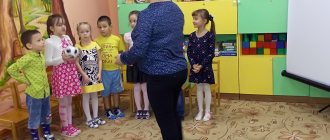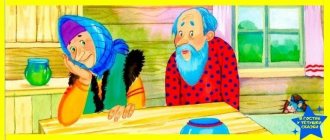Kolobok. Lesson on fiction Russian folk tale
Date:__________________________ Fiction. Topic: “Kolobok” Russian folk tale. Program content: 1. To consolidate familiar fairy tales in children’s memory, recognize them by fragments, illustrations, objects, etc. 2. Develop thinking, memory, imagination. 3.Cultivate interest and love for fairy tales. 4. Literacy - continue to work on the sentence, its verbal composition, analyze, write them down schematically. 5. Formation of the skill of coordinating hand movements when writing. 6. Develop eye and fine motor skills. Equipment: Illustrations for fairy tales - “The Wolf and the Seven Little Goats”, “The Ryaba Hen”, “The Little Fox-Sister and the Gray Wolf”; exhibition of books on fairy tales; ball; toys - hare, fox, bear, wolf, bun; notebooks; a yellow pencil for each child; Progress of the lesson 1. Organizational moment, announcement of the topic: - Guys, do you like fairy tales? (Yes.) You already know a lot of fairy tales. And today we have gathered to once again remember our favorite fairy tales, to find out which of you knows more fairy tales. So, the journey to the land of fairy tales begins! Reading the poem by F. Krivin “The floorboard is creaking about something”: The floorboard is creaking about something, And the knitting needle can’t sleep again, Sitting down on the bed, the pillows Already perked up their ears. And immediately the faces change, the sounds and colors change... The floorboard creaks quietly, a fairy tale walks around the room... The game: “You give me - I give you.” (Children stand in a circle. The leader from the middle of the circle throws the ball to the children, naming the animal. Children take turns answering in which fairy tale this hero appears.) For example: cow - fairy tale “Kroshechka - Khavroshechka.” Goat -…; Bear -…; Wolf -…; Geese -…; Fox -…; Chicken -…; Hare -... Well done! - We quietly sit down at the table. 2. Main part: - Fairy tales tell about the unprecedented, the miraculous, and they come in different forms: folk and original. — Guys, why do you think fairy tales are called folk tales (because they were composed by the people). Fairy tales were passed from one person to another. Therefore, fairy tales belong to oral folk art. — Why are fairy tales called author’s fairy tales? (because they were composed and written by one person - the author). Fairy tales are good. In every fairy tale...(good) always wins, and evil always...(is punished). Game: “Find out a fairy tale from a riddle” - Guys, do you know a lot of fairy tales? (Yes). Let's check it now. I will ask you riddles, and you will name a fairy tale. ** A girl appeared in the cup of a flower, And that girl was a little larger than a marigold. (Thumbelina) **Near the forest, on the edge, Three of them live in a hut. There are three chairs and three mugs, three beds, three pillows. Guess without a hint, who are the heroes of this fairy tale? (Three Bears) **He treats small children, Heals birds and animals, The Good Doctor looks through his glasses... (Aibolit). Game: “Recognize the fairy tale from the picture” - Well done, you can recognize the fairy tale from the riddle. And try to recognize the fairy tale from the illustration (on the board there are illustrations for the fairy tales “The Wolf and the Seven Little Goats”, “The Rock Hen”, “The Little Fox-Sister and the Gray Wolf”). 1) - Guys, look and tell me what fairy tale this illustration is from? — shows an illustration from the fairy tale “The Wolf and the Seven Little Goats” (This is the fairy tale “The Wolf and the Seven Little Kids.”) — Who composed it? (This is a Russian folk tale.) - Guys, “The Wolf and the Seven Little Goats” is a German fairy tale, a fairy tale by the Brothers Grimm. It became widespread in Russia, became part of oral folk art and, with some changes in the plot, received the status of a “Russian folk tale.” - What does this fairy tale teach us? (Because you can’t open the door for strangers, listen to your mother, don’t be evil like a wolf, but you have to be kind.) 2) - Look and tell me which fairy tale this illustration is from? — shows an illustration from the fairy tale “Ryaba Hen” (This is the fairy tale “Ryaba Hen.”) — Which chicken in this fairy tale is good or bad? (The chicken is good. She gave her grandfather and grandmother a golden egg, and when the mouse broke it, she took pity on them and laid another egg for them.) Game: “Recognize the fairy tale by the heroes” - I will name the fairy-tale heroes, and you will remember the names of the fairy tales, in which they act. 1. Grandfather, bug, granddaughter, mouse. (Fairy tale “Turnip”) 2. Mouse, grandmother, egg. (Fairy tale “Rocktail Hen”) 3. A very little girl, a cockchafer, a swallow, a mouse. (Fairy tale “Thumbelina”) 4. Tsar, three sons, arrow, swamp. (Fairy tale “The Frog Princess”) Guess the riddle: It is shaped like a ball. He was once hot. He jumped off the table onto the floor and left his grandmother. He has a ruddy side... Did you recognize it? (BONK)
.
— Guys, here are fairy-tale characters (toys): a hare, a wolf, a fox, a bear, and a bun. Questions: - Which of the fairy-tale heroes is the odd one out in this series? (Kolobok) - What can you call the other heroes? (wild animals) - What other heroes can you add? (old man, old woman) - What is the name of this fairy tale? (Fairy tale "Kolobok"). Fizminutka We walked through fairy tales and talked about them We stomped our feet, we clapped our hands They will remember us in fairy tales, we bent down “one”, we rose up “two”, we smiled at everyone And again we stomped and clapped our hands. What great fellows, what daredevils! Reading the fairy tale “Kolobok” -
What was Kolobok like?
—What does a fairy tale teach? -What was Kolobok made of? -What else can be made from flour? — How should you treat bread? Work in a notebook.
-p.35 -Circle around food products made from flour with a simple pencil. (Mutual check) - Guys, do you feel sorry for Kolobok?
Why? Let's come up with a different ending to the story. — Draw a house for Kolobok in which he could hide from the sly fox. .
Summing up: - Well done! I want to thank you on behalf of all fairy-tale heroes. You know fairy tales well, but I think each of you has a favorite fairy tale. Name it.
Game-based activity for children of the second year of life, theme: “Kolobok”
Author of the lesson: Svetlana Aleksevna Davydova, teacher and methodologist of the highest qualification category.
Equipment:
Toys: bun, big and small hare according to the number of children, fox, wolf, bear. Large and small carrots. Cardboard silhouettes of a wolf with clothespins attached to it. Plasticine, boards for modeling. Balls and trays in matching colors. Cones, basket. Audio recording of the song “Sunshine”. Finger paints, sheets of paper with a painted bush. Sheets of green paper, yellow circle, glue. Doll dishes: pots, plates, spoons. Millet cereal. Corrective mat, arch, stumps.
Summary of a game lesson for children of the third year of life, topic: “Kolobok”
Author of the lesson: Svetlana Alekseevna Davydova, teacher-methodologist of the highest qualification category.
Equipment:
Toys: bun, big and small hare according to the number of children, fox, wolf, bear. Large and small carrots. Cardboard silhouettes of a wolf with clothespins attached to it. Plasticine, boards for modeling. Balls and trays in matching colors. Cones, basket. Audio recording of the song “Sunshine”. Finger paints, sheets of paper with a painted bush. Sheets of green paper, yellow circle, glue. Transparent cups with water, brushes, gouache. Corrective mat, arch, stumps.
Bear
The teacher shows the toy and offers to play with it.
Staging "Teddy Bear"
A clubfooted bear is walking through the forest. (Waddle with legs apart)
He collects cones and sings songs. (Tilts)
Suddenly a cone fell right on the bear’s forehead. (Put your fist to your forehead)
The bear got angry and “stomp” with his foot! (Stamp your foot)
Game and palm massage “Collect cones”
Finger painting “Berries for the bear”
Here a bush has grown. Let's make it grow sweet red berries. The bear will come, enjoy it and not eat the kolobok.
Dynamic pause “Along the forest path”
Children, one after another, walk along the correction mat, crawl under the arc, step over stumps, and jump over bumps.
The teacher shows the toy and offers to play with it.
Water coloring “Juice for the Fox”
The fox is very thirsty. Let's prepare some juice for her. Children dip a brush into paint and rinse it in a clear cup. The teacher asks what color the juice is.
Construction game “Build a bridge across the river”
The fox can't swim, but he needs to cross the river. Build a bridge from cubes. Place the cubes tightly together to prevent the fox from falling.
Didactic game “Who ran away?”
Toys of a hare and a fox are placed in front of the children. Cover with a scarf and remove one toy. Children must guess who ran away.
Farewell "Rattle"
Rattle, rattle, musical toy, take it in your hand and rattle, rattle, rattle! Hide the rattle behind your back to give your ears a rest from the noise. Look at your neighbors and sit quietly. Look at your neighbors and go home.
Source
Bear
Staging "Teddy Bear"
A clubfooted bear is walking through the forest. (Waddle with legs apart)
He collects cones and sings songs. (Tilts)
Suddenly a cone fell right on the bear’s forehead. (Put your fist to your forehead)
The bear got angry and “stomp” with his foot! (Stamp your foot)
Game and palm massage “Collect cones”
Bas-relief sculpture “Berries for a bear”
Here a bush has grown. Let's make it grow sweet red berries. The bear will come, enjoy it and not eat the kolobok.
Dynamic pause “Along the forest path”
Children, one after another, walk along the correction mat, crawl under the arch, and step over the stumps.
"Feed the fox porridge"
Children use a spoon to transfer cereal from a doll's saucepan into doll's plates. The toy fox comes up to everyone, “eats” the porridge and promises not to eat the kolobok.
Didactic game “Who ran away?”
Toys of a hare and a fox are placed in front of the children. Cover with a scarf and remove one toy. Children must guess who ran away.
Farewell "Rattle"
Rattle, rattle, musical toy, take it in your hand and rattle, rattle, rattle! Hide the rattle behind your back to give your ears a rest from the noise. Look at your neighbors and sit quietly. Look at your neighbors and go home.
Source

